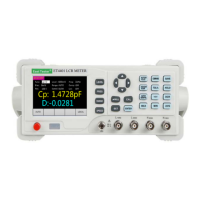
Do you have a question about the East Tester ET44 Series and is the answer not in the manual?
| Brand | East Tester |
|---|---|
| Model | ET44 Series |
| Category | Test Equipment |
| Language | English |
Checks to confirm all items are attached to the bridge, including optional accessories.
Instructions for connecting the power supply voltage and frequency range.
Information about using the provided fuses for the instrument.
Conditions for optimal operation and storage, including temperature and humidity.
Guidelines for using test fixtures and cables for accurate measurements.
Recommended warm-up time and continuous working hours for accurate measurements.
Power consumption and dimensions of the instrument.
Lists key technical specifications like supply voltage, environment, dimensions, and mass.
Identifies the components and controls on the front panel of the LCR meter.
Explains the function of various basic and directional keys on the instrument.
Identifies the connectors and power input on the rear panel.
Describes the different interfaces of the LCR meter (measurement, setting, system).
Instructions for starting up and shutting down the instrument.
Details how to select and adjust various measurement parameters like frequency and level.
Steps for setting nominal values and comparator thresholds for sorting.
How to perform list scanning over multiple frequencies for comparison.
How to enter the DC resistance measurement mode.
How to enter the electrolytic capacitor measurement mode.
How to use the relative measurement function with a reference value.
How to activate and deactivate the data retention function.
How to record and display MAX, MIN, and AVG measurement values.
Describes open circuit and short circuit correction procedures.
How to configure parameters that load on power-on.
How to enable or disable the buzzer.
Defines main and secondary measurement parameters and their combinations.
Explains series and parallel equivalent circuit modes for components.
Details the basic accuracy specifications under various conditions.
Accuracy specifications for DC Resistance measurements across ranges.
Accuracy of the test signal frequency.
Accuracy of the test signal level.
Accuracy of the output impedance.
Lists the display ranges for various measurement parameters.
Information about the USB communication interface for computer connection.
Details the RS232 connector and pin definition.
Reference for SCPI commands, with contact information for details.
Information on instrument packaging for protection against environmental factors.
Guidelines for handling and transporting the instrument safely.
Recommended storage conditions for the instrument to maintain performance.
Information on maintenance, repair, and warranty coverage.